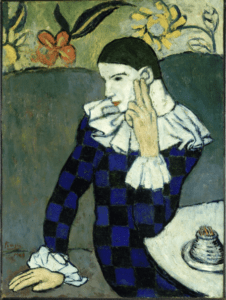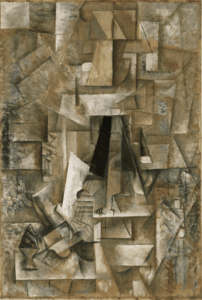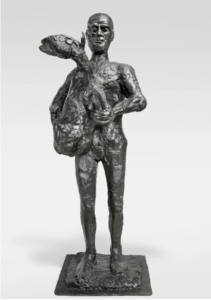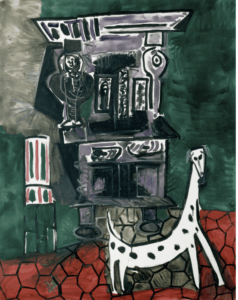A Closer Look at Gagosian’s ‘A Foreigner Called Picasso’
By Ruth Wecker
This past winter, the Gagosian Gallery’s Chelsea location on West 21st Street presented A Foreigner Called Picasso, an exhibition of Pablo Picasso’s art that told the story of his residency in France from 1900 to his death in 1973. April 2023 marked fifty years since Picasso’s death, and A Foreigner Called Picasso was a part of the transnational program Picasso Celebration 1973–2023: 50 Exhibitions and Events to Celebrate Picasso dedicated to his unmatched contributions to art. A Foreigner Called Picasso opened in November of 2023 and remained on display until February 10th, 2024. With this show, curators Annie Cohen-Solal and Vérane Tasseau brought museum-level standards of education to the Gagosian Gallery and delved into Picasso’s life as an outsider in France through his art.
Arranged chronologically, the exhibition illustrated the evolution of Picasso’s art parallel to his residency in France. A gallery in the middle of the show was dedicated entirely to wall text and reproductions of letters, files, photographs, and other works by Picasso that provided a tremendous amount of context to the exhibition, yet were not physically acquired. Each of the four walls in this gallery was dedicated to one period of Picasso’s life. The curators divided and titled the four periods as follows: “1900-1914: Suspected Anarchist and Leader of the Avant-Garde in the Labyrinth of Paris”; “1919-1939: A World War, a Civil War, and a Mercurial Artist under Siege”; “1940-1955: World War II, the Communist Party as a Homeland, and the Artist’s Emergence as Hero”; “1955-1973: Head of a Mediterranean Tribe in his Kingdom”. Picasso’s relationship with France was complex, and Gagosian’s A Foreigner Called Picasso sought to unearth the nuances of that relationship through his art.
A Foreigner Called Picasso was not your average gallery show, and this central room was a major reason why. A commitment to education of this scale—an entire gallery room—is hardly a standard of most museum shows, let alone a gallery show. Much of the exclusivity of a gallery is born from its lack of provided information, thus permitting only those with previous knowledge of the works to make sense of what is on display. At first glance, A Foreigner Called Picasso resembled a traditional gallery: the walls were clean and white and the object identifications were neatly grouped and stacked on the wall off to the side, as opposed to accompanying each work as would be the case in a museum. The central gallery of text and reproductions showed an uncommon commitment to education; it welcomed Picasso experts and novices alike and created a welcoming, curious, and intellectual environment for the viewer to move through.

A Foreigner Called Picasso featured some significant works of Picasso’s. This collection was a testament to the gallery’s status and wealth and also to the massive amount of art Picasso produced during his lifetime. Competing with local institutions such as The Metropolitan Museum and The Museum of Modern Art— both of which had one or more ongoing shows on Picasso, as well as an extensive amount of his work in their permanent collections— Gagosian’s high level of curatorial means was exhibited through the objects in this show. The opening work was on loan from The Met, one of the top art institutions in the world, and it set the tone for the show. Seated Harlequin painted in 1901 is the first of many depictions of this lone entertainer that appear throughout Picasso’s oeuvre. For Picasso, the harlequin, a character that originated as a part of the Italian theater group Commedia dell’arte during the 16th century, represents the part of himself that feels like an outsider in France. Picasso first settled in the artistic bohemian neighborhood of Montmartre, but despite being among fellow recluses he was still very much on the fringe of society. Pensive, bold, and in costume, Picasso’s Seated Harlequin, a quasi-self-portrait in and of itself, was displayed alongside Self-Portrait (Yo) from 1901. The two works greeted you at the entrance of the exhibition and invited you into Picasso’s weird, wild world of entertainment, creativity, and personal expression in the face of ostracization.
Picasso’s first decade in Paris was defined by his perceived criminality, an era the curators titled “1900-1914: Suspected Anarchist and Leader of the Avant-Garde in the Labyrinth of Paris”. This title refers to the general suspicion held by the French Police that Picasso, due to his connections to the Catalans, was an anarchist. France, historically and steadfastly a nationalistic nation, was wary of all foreigners, especially those who could not speak the language and who were not accepted into high social classes. Consequently, documents on Picasso were compiled and archived by the French Police throughout his lifetime. Everything from photographs to fingerprints were kept in files, making him look more like a run-of-the-mill criminal than the most prolific artist of the century. Annie Cohen-Solal zeroed in on this phenomenon in her exhibition, and the book that inspired it, Picasso l’étranger, to tell the all-too-common story of a foreigner treated like a criminal.
Despite this treatment, Picasso did not reject France as it attempted to reject him. Instead, the nation became one of his biggest inspirations and the birthplace of his most creative, radical, and revolutionary moments in art. He formed close working relationships with French artists, writers, dealers, and critics and led the charge to make Paris the center of Modern Art in the first half of the 20th century. By introducing the viewer to Picasso’s near-immediate suspected criminal status upon his arrival to France, the rest of his works in the show can be understood to be in response to and in defiance of that false identity.

Foreigner or not, no one in France could ignore the unprecedented scale of the two World Wars, and Picasso’s art reflects that he was no exception to the wars’ influence. It was Picasso, a Spaniard, who inserted one of the first signs of pro-French symbolism into a painting at the onset of World War I in his work Playing Cards, Glasses, Bottle of Rum: “Vive la France”(1914). Despite his patriotism, Picasso was still subject to suspicion, and in 1914 around three hundred of his works were seized by the French government. Picasso’s dealer, a German expatriate named Daniel Henry-Kahnweiler who is largely responsible for putting Cubism on the map, only increased France’s suspicions of the Spanish artist’s loyalty to the Entente. Picasso and Kahnweiler, among others, are why Picasso’s invention of Cubism is a story of foreigners in France at a time when they were not entirely welcomed. Cubist works such as The Reservoir, Horta de Ebro (1909), and Man with a Guitar (1912) were featured in this exhibition and exemplify Picasso’s continued ostracism even as he placed Paris at the center of avant-garde art.
Continuing to move forward through time, the second portion of A Foreigner Called Picasso took a look at the interwar years in France. The exhibition titled the period between 1919 to 1939 as “A World War, A Civil War, and a Mercurial Artist under Siege”. This era shows Picasso following the return-to-order movement while continuing to experiment with Cubism and other avant-garde art movements. Wall text in the central gallery room explained that Picasso’s relationship with the Russian ballet company led by choreographer Serge Diaghilev, the Ballets Russes, exposed a new realm of French society to Picasso’s work. Through the Ballets Russes Picasso aligned himself simultaneously with high French society and Russia, an important ally to the French. By 1932 he had fame, success, and wealth, but the Spanish Civil War forced a change in Picasso’s subject matter. Up until works like Guernica (1937), reproduced alongside wall text in the central room, which asserted him as a staunch anti-fascist, only veiled allusions to politics had appeared in his paintings.

1940 to 1955, the era labeled “World War II, the Communist Party as a Homeland, and the Artist’s Emergence as Hero”, was the pinnacle of the exhibition. Picasso, now four decades into his residency in France, requested naturalization in 1940 and was denied. This is the event that inspired Cohen-Solal’s book and subsequent exhibition. To answer the question of how someone so important to French society and culture who had lived in France for the majority of their life and hailed from a neighboring Latin European country could not only be rejected, but seen as a threat requires a deep understanding of politics, history, and diplomatic relations at the onset of World War II. A Foreigner Called Picasso attempts to answer this question through Picasso’s art, and his 1943 life-size sculpture, Man with a Lamb holds great significance. The sculpture, unmissable and incomparable to the rest of the room, whose walls were lined with sketches and smaller sculptures, stood alone against the back wall of the second to last gallery. Man with a Lamb is a direct response to works by Arno Breker, Hitler’s favorite artist. Though denied by Picasso himself, the sculpture cannot escape its association with the biblical good shepherd. This religious imagery evokes hopefulness and a steadfast resistance to oppressors. Just as this work cannot help but give itself to symbolism, Picasso could not escape being read as a political artist, especially as he continued to make art as an anti-fascist, anti-Franco Spanish foreigner in Nazi-occupied France.

The show ends with “Head of a Mediterranean Tribe in His Kingdom”, the period from 1955 to 1973 during which Picasso lived out the rest of his life in the South of France. Picasso’s return to the Mediterranean as a world-renowned artist and cultural icon can be seen as the death of his status as a foreigner. This was his home, “his kingdom,” and the multicultural atmosphere combined with his accumulated and extensive ties to other artists bred some of his most creative and experimental work. The Gagosian show concluded with a room of large works including Buffet Henri II, Vauvenargues from 1959. This particular work exemplifies Picasso’s experimentation with color. In his early life, he often employed monochromatic palettes such as those seen during his so-called Blue and Rose Periods, or in the grisaille palette of his Cubist works. When he forged the charge of Surrealism later in his career his color palette shifted to be more diverse and surprising, yet it remained pleasing to the eye. In Buffet Henri II, Vauvenargues, however, his combination of red, green, and purple is harsh and inharmonious. This work emphasizes the sense one gets when observing his work that Picasso did anything and everything conceivable to do in art during his ninety-two years on Earth. Any medium, any color combination, any style, or any theme he was able to not only execute but master and reinvent. The works displayed in A Foreigner Called Picasso provided a small peek into his ceaseless world of art in conjunction with and despite his outsider status in France.
Picasso’s complicated relationship with France, as the show exhibited, outlives him. In a small room separated and removed from the exhibition was a tiny collection of works by Claude Ruiz Picasso, Picasso’s son with the French painter Francoise Gilot, and the head of his estate for 30 years. Claude Ruiz Picasso represents, in more ways than one, Picasso’s significance and legacy over the last fifty years. Born out of wedlock, Ruiz Picasso helped pass a law legitimizing the inheritance of an estate to illegitimate children in France. In his The New York Times obituary, Ruiz Picasso’s work managing the estate is honored by the owner of the Gagosian Gallery. Larry Gagosian states, “I think he did an incredible job as a steward of his father’s legacy…He took it seriously and was extremely strict about how the Picasso image was handled.” Picasso’s image lives on through his work, his descendants, and exhibitions such as A Foreigner Called Picasso that continue to tell his story from new and thoughtful angles.
Work Cited
“A Foreigner Called Picasso: Curated by Annie Cohen-Solal and Vérane Tasseau, West 21st Street, New York, November 10, 2023–February 10, 2024.” Gagosian, 15 Aug. 2023,
gagosian.com/exhibitions/2023/a-foreigner-called-picasso-curated-by-annie-cohen-solal-and-verane-tasseau/.
Cohen-Solal, Annie, “A Foreigner Called Picasso: Essay.” Gagosian Quarterly, 8 Nov. 2023, gagosian.com/quarterly/2023/11/08/essay-a-foreigner-called-picasso/.
Sandomir, Richard. “Claude Ruiz-Picasso, Who Ran His Artist Father’s Estate, Dies at 76.” The New York Times, August 27, 2023,
https://www.nytimes.com/2023/08/27/arts/claude-ruiz-picasso-dead.html.
Tempkin, Ann. “Pablo Picasso, Man with a Lamb, 1943.” MoMA, Accessed 19 Jan. 2024,
https://www.moma.org/audio/playlist/18/398.
All images © 2023 Estate of Pablo Picasso/Artists Rights Society (ARS), New York

